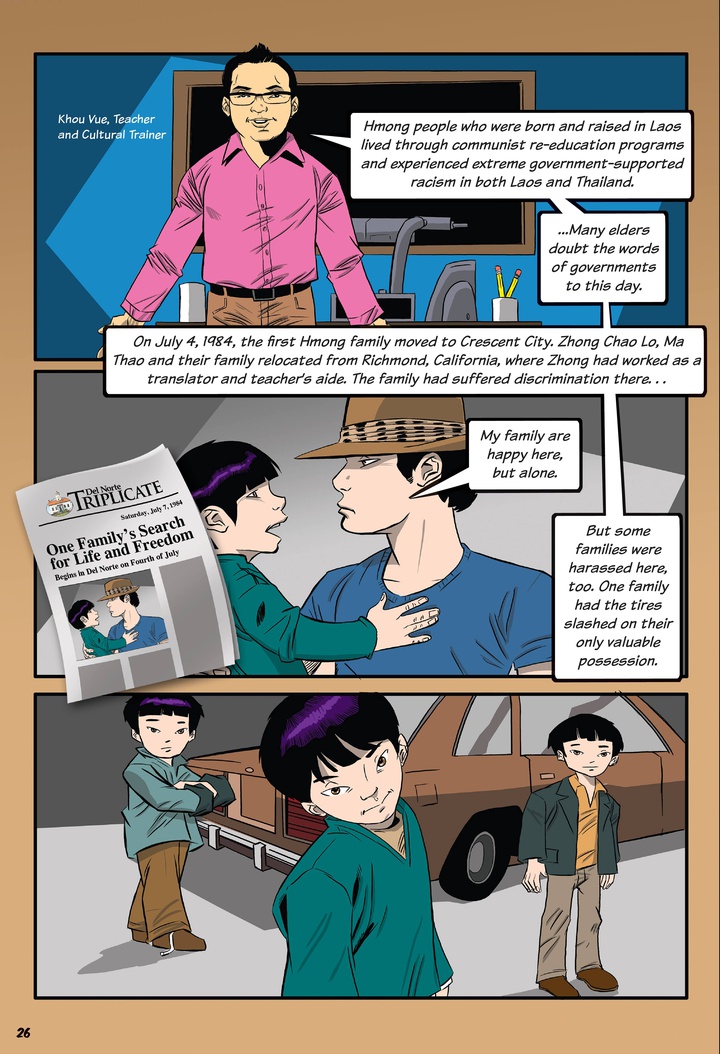Jessica Cejnar / Wednesday, Dec. 11, 2019 @ 3 p.m. / Community
Graphic Novel Takes Honest Look At Del Norte History

The history of Del Norte's Hmong community is part of a graphic novel that seeks to tell the county's story. Illustration by Robert Love; courtesy of True North Organizing Network and The California Endowment
Melissa Darnell knew that doing justice to Del Norte County’s story that meant starting at the beginning — literally.
Tasked with spearheading a graphic novel project through The California Endowment and True North Organizing Network, Darnell realized that Del Norte’s history starts with the community’s indigenous people.
“We have four federally recognized tribes who believe the Creator placed them here in a land that was resource-rich and abundant and gave them everything they needed to be happy and healthy,” she said. “There’s been a long story arc that has helped us get to where we are.”
The graphic novel, “How Did We Get Here” tells the story of those who call Del Norte County home. The novel tells of the massacres of the Tolowa people; the persecution of Yurok residents in Klamath; immigration raids on the Del Norte County Latino community in the 1970s and 80s; and the challenges for the first Hmong community to settle in Crescent City in 1984, Darnell told the Wild Rivers Outpost.
While Darnell was tapped as the project manager, College of the Redwoods English professor Ruthe Rhodes wrote the script. Oakland-based Robert Love illustrated the novel.
While crafting the story and ensuring its accuracy, Darnell said she, Love and Rhodes worked with Building Healthy Communities representatives Geneva Wiki and Michelle Carrillo. They discussed what needed to “make the cut” with the Yurok Tribe’s cultural committee and Tolowa Dee-ni’ Nation representative, historian and linguist Loren Bommelyn.
Bommelyn gave Love, Rhodes and Darnell a tour of Pebble Beach Drive, pointing out former Tolowa village sites, Darnell said. She said Bommelyn also discusses a massacre at Peacock Bar that resulted in the death of his grandparents.
“(The) Peacock family literally killed his grandparents,” Darnell told the Outpost, adding that some of Del Norte’s history may be difficult for people to come to grips with. “The Peacocks are still in the community. They probably aren’t going to be excited that part of the family legacy is now in print in such, sort of, a public way.”
The novel will include other significant events in local indigenous history. Rhodes said one thing she didn’t realize before working on the script was how systematic the removal of the Yurok and Tolowa people from their own land was.
Rhodes noted that it was a bounty system, the enslavement of people’s children, supported by the government.
“I knew about it, but I did not understand the depth of it and I don’t understand the depth of it today,” she said. “But it helped me get a better perspective on why people are still so sensitive about what happened and why it’s not appropriate to say, ‘Look forward.’ We don’t understand where we are unless we look back, and we can’t understand our neighbors unless we look back.”
Rhodes said it was one of her previous works, a musical Lighthouse Repertory Theatre produced in 2014 called “This Is Crescent City” that led to her involvement in “How Did We Get Here.” The LRT musical showed the community’s history through various lenses, bringing up the importance of social justice and how Crescent City’s history created systems and policies people experience today, Rhodes told the Outpost.
Rhodes also recently published a collection of essays focusing on prominent members of Del Norte County called “Come To The Edge.”
“How Did We Get Here” is the first comic book script Rhodes has written. She said she taught herself the format via books and through talking to people who had written graphic novels previously.
Rhodes said the graphic novel is different than her other projects because it involves working closely with the illustrator to make sure the pictures and words go together.
“Another one of the things that’s really hard is you can’t say very much,” Rhodes said. “There’s not a lot of room for words and we wanted the script to reflect the collaboration with other words. I wasn’t going to write Hilda’s words; I wasn’t going to write Loren Bommelyn’s words. I wanted to be respectful for people being able to speak for themselves.”
Darnell, Rhodes and True North unveiled “How Did We Get Here” at the Hmong New Year celebration on Saturday. Khou Vue, founder of the Hmong Cultural Center of Del Norte County, California, was one of the collaborators.
Rhodes said Vue and Pa Xiong at the Cultural Center helped with the novel’s initial concept and read the script when it was completed to make sure everything rang true for them.
In a written statement, True North Organizing Network Executive Director Terry Supahan said the Hmong people’s role in the secret CIA-led war in Laos during the Vietnam War era is unknown to many Americans.
“The graphic novel provides an opportunity to introduce this important history to a new generation of readers,” Supahan said.
Vue told the Outpost that he was excited to see the finished product.
“This will be something that will live forever for my children,” he told the Outpost. “It’s our local history. I know my children are looking forward to reading these facts we’ve lived through.”
A formal event will be announced in January to launch the graphic novel, according to the True North press release.
CLICK TO MANAGE